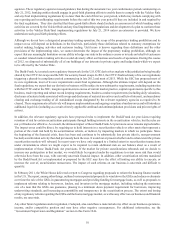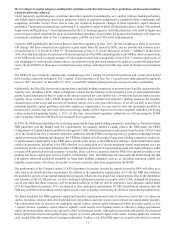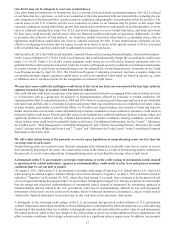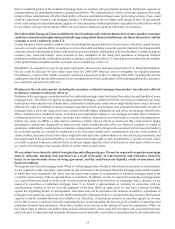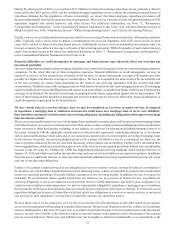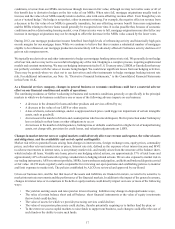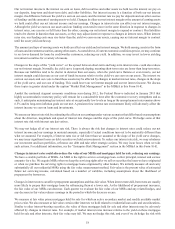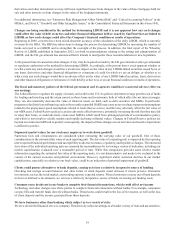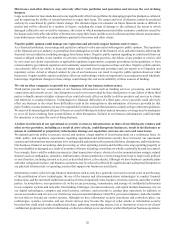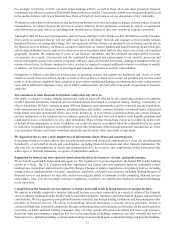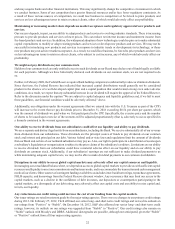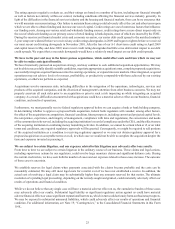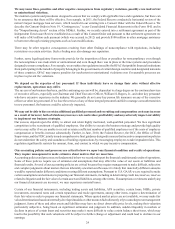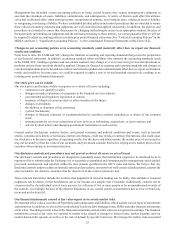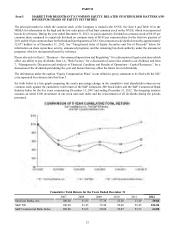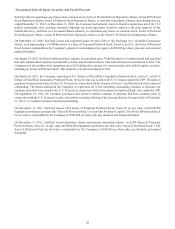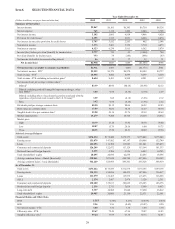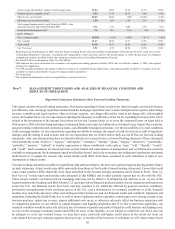SunTrust 2012 Annual Report Download - page 36
Download and view the complete annual report
Please find page 36 of the 2012 SunTrust annual report below. You can navigate through the pages in the report by either clicking on the pages listed below, or by using the keyword search tool below to find specific information within the annual report.20
Hurricanes and other disasters may adversely affect loan portfolios and operations and increase the cost of doing
business.
Large scale natural or man-made disasters may significantly affect loan portfolios by damaging properties pledged as collateral
and by impairing the ability of certain borrowers to repay their loans. The nature and level of disasters cannot be predicted
and may be exacerbated by global climate change. The ultimate impact of a disaster on future financial results is difficult to
predict and will be affected by a number of factors, including the extent of damage to the collateral, the extent to which
damaged collateral is not covered by insurance, the extent to which unemployment and other economic conditions caused by
the disaster adversely affect the ability of borrowers to repay their loans, and the cost of collection and foreclosure moratoriums,
loan forbearances and other accommodations granted to borrowers and other clients.
Negative public opinion could damage our reputation and adversely impact business and revenues.
As a financial institution, our earnings and capital are subject to risks associated with negative public opinion. The reputation
of the financial services industry in general has been damaged as a result of the financial crisis and other matters affecting the
financial services industry, including mortgage foreclosure issues. Negative public opinion regarding us could result from our
actual or alleged conduct in any number of activities, including lending practices, the failure of any product or service sold
by us to meet our clients' expectations or applicable regulatory requirements, corporate governance and acquisitions, or from
actions taken by government regulators and community organizations in response to those activities. Negative public opinion
can adversely affect our ability to keep and attract and/or retain clients and personnel and can expose us to litigation and
regulatory action. Actual or alleged conduct by one of our businesses can result in negative public opinion about our other
businesses. Negative public opinion could also affect our credit ratings, which are important to accessing unsecured wholesale
borrowings. Significant changes in these ratings could change the cost and availability of these sources of funding.
We rely on other companies to provide key components of our business infrastructure.
Third parties provide key components of our business infrastructure such as banking services, processing, and internet
connections and network access. Any disruption in such services provided by these third parties or any failure of these third
parties to handle current or higher volumes of use could adversely affect our ability to deliver products and services to clients
and otherwise to conduct business. Technological or financial difficulties of a third party service provider could adversely
affect our business to the extent those difficulties result in the interruption or discontinuation of services provided by that
party. Further, in some instances we may be responsible for failures of such third parties to comply with government regulations.
We may not be insured against all types of losses as a result of third party failures and our insurance coverage may be inadequate
to cover all losses resulting from system failures or other disruptions. Failures in our business infrastructure could interrupt
the operations or increase the costs of doing business.
A failure in or breach of our operational or security systems or infrastructure, or those of our third party vendors and
other service providers, including as a result of cyber attacks, could disrupt our businesses, result in the disclosure or
misuse of confidential or proprietary information, damage our reputation, increase our costs and cause losses.
We depend upon our ability to process, record, and monitor a large number of client transactions on a continuous basis. As
client, public, and regulatory expectations regarding operational and information security have increased, our operational
systems and infrastructure must continue to be safeguarded and monitored for potential failures, disruptions, and breakdowns.
Our business, financial, accounting, data processing, or other operating systems and facilities may stop operating properly or
become disabled or damaged as a result of a number of factors including events that are wholly or partially beyond our control.
For example, there could be sudden increases in client transaction volume; electrical or telecommunications outages; natural
disasters such as earthquakes, tornadoes, and hurricanes; disease pandemics; events arising from local or larger scale political
or social matters, including terrorist acts; and, as described below, cyber attacks. Although we have business continuity plans
and other safeguards in place, our business operations may be adversely affected by significant and widespread disruption to
our physical infrastructure or operating systems that support our businesses and clients.
Information security risks for large financial institutions such as ours have generally increased in recent years in part because
of the proliferation of new technologies, the use of the internet and telecommunications technologies to conduct financial
transactions, and the increased sophistication and activities of organized crime, hackers, terrorists, activists, and other external
parties. As noted above, our operations rely on the secure processing, transmission, and storage of confidential information
in our computer systems and networks. Our banking, brokerage, investment advisory, and capital markets businesses rely on
our digital technologies, computer and email systems, software, and networks to conduct their operations. In addition, to
access our products and services, our clients may use personal smartphones, tablet PCs, personal computers, and other mobile
devices that are beyond our control systems. Although we have information security procedures and controls in place, our
technologies, systems, networks, and our clients' devices may become the target of cyber attacks or information security
breaches that could result in the unauthorized release, gathering, monitoring, misuse, loss or destruction of our or our clients'
confidential, proprietary and other information, or otherwise disrupt our or our clients' or other third parties' business operations.


